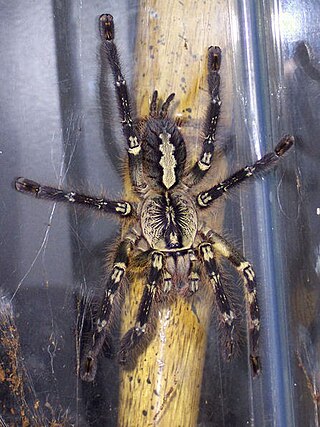
The grizzled giant squirrel is a large tree squirrel in the genus Ratufa found in the highlands of the Central and Uva provinces of Sri Lanka, and in patches of riparian forest along the Kaveri River and in the hill forests of Karnataka, Tamil Nadu and Kerala states of southern India. The International Union for Conservation of Nature (IUCN) lists the species as near threatened due to habitat loss and hunting.

Poecilotheria is a genus of tarantulas native to India and Sri Lanka. It was first described by Eugène Louis Simon in 1885. They are arboreal tarantulas, commonly known as ornamental tarantulas, known for their vivid color patterns, fast movement, and potent venom compared to other tarantulas. As of 2019 all species are protected under CITES.

Mannar District is one of the 25 districts of Sri Lanka, the second level administrative division of the country. The district is administered by a District Secretariat headed by a District Secretary appointed by the central government of Sri Lanka. The capital of the district is Mannar, which is located on Mannar Island.
This glossary describes the terms used in formal descriptions of spiders; where applicable these terms are used in describing other arachnids.

Poecilotheria ornata, known as the fringed ornamental or ornate tiger spider, is a large arboreal tarantula, which is endemic to Sri Lanka. Their legspan sometimes reaches 10 inches (25 cm) in females, and is probably the second largest of the genus, behind Poecilotheria rufilata.
Poecilotheria hanumavilasumica, also known as the Rameshwaram ornamental, or Rameshwaram parachute spider, is a critically endangered species of tarantula.

Poecilotheria rajaei is a tarantula in the genus Poecilotheria endemic to Sri Lanka.
Poecilotheria miranda, also known as the Bengal ornamental is a species of tarantula. The species is endemic to India.

Poecilotheria fasciata, the Sri Lanka ornamental or Sri Lanka ornamental tiger spider, is a large arboreal tarantula. It is endemic to central Sri Lanka.

Poecilotheria vittata, sometimes called Pederson's ornamental, the ghost ornamental, or magam tiger spider, is an arboreal tarantula. It is endemic to Sri Lanka. In IUCN Red List, the species is cited as a synonym of Indian species Poecilotheria striata, but in other local text books and online publications, it is cited as a separate species. As of February 2016, the species was considered to be native to both India and Sri Lanka by the World Spider Catalog.

Poecilotheria subfusca, or the ivory ornamental, is a spider in the tarantula family, Theraphosidae. It is endemic to Sri Lanka. As of February 2019, the World Spider Catalog regarded Poecilotheria bara as a synonym. Other sources, particularly in the pet trade, have treated highland and lowland forms as distinct species, with the lowland forms being P. bara.

Poecilotheria rufilata, also known as the red slate ornamental, reddish parachute spider, Travancore slate-red, or rufus parachute spider, is an arboreal tarantula. It is endemic to South Western Ghats of India. It is classed as "endangered", threatened by habitat loss and smuggling for the pet trade.
Poecilotheria tigrinawesseli, also known as Wessel's tiger ornamental or Anantagiri's parachute spider, is an arboreal tarantula. It is endemic to Eastern Ghats of India and known from six locations around Andhra Pradesh.
Sphegina crinita is a species of hoverfly in the family Syrphidae found in Malaysia and Indonesia. It's easily identified by its superior lobes, the left side one being pushed over the medial line of the hypandrium to the right side so that the right side one seems bilobed. Otherwise, the genitalia are nearly identical to those in S. fimbriata.
Sphegina uncinata is a species of hoverfly in the family Syrphidae found in Myanmar. It's easily identified by a straight dorsal line of frontal prominence that ends just before the ocellar triangle, a strongly projecting mouth edge, and a vibrissal angle more strongly protruding than the frontal prominence.
Sphegina (Asiosphegina) atricolor is a species of hoverfly in the family Syrphidae found in Myanmar.
Sphegina (Asiosphegina) bidens is a species of hoverfly in the family Syrphidae found in Myanmar.
Sphegina (Asiosphegina) bilobata is a species of hoverfly in the family Syrphidae found in Myanmar. It's set apart from other species by its general pale yellowish color with three black longitudinal stripes on the scutum combined with the infuscated pattern at cross veins on the wing. The male sternite IV with its symmetrical pair of short spinose lobes posteriorly is quite distinct.










